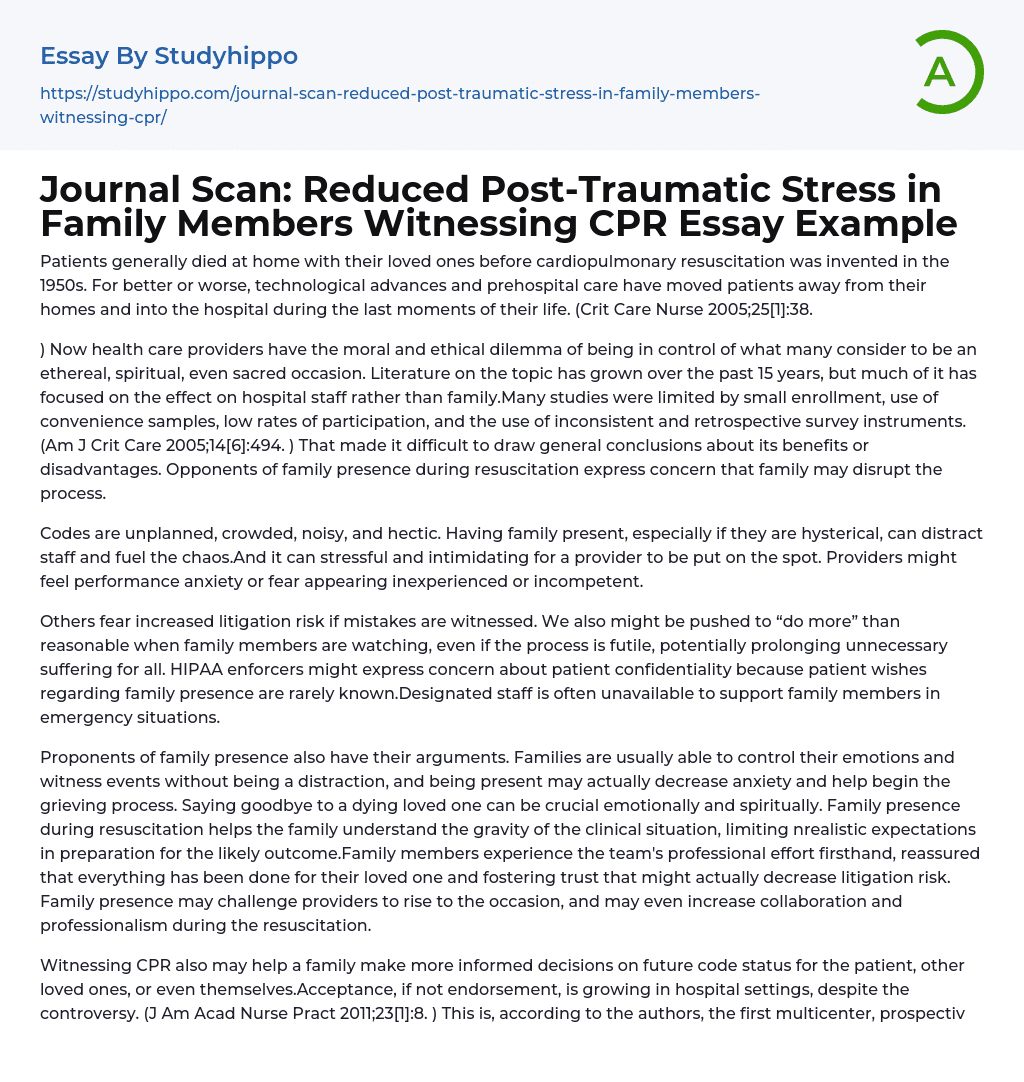

Journal Scan: Reduced Post-Traumatic Stress in Family Members Witnessing CPR Essay Example
Before the 1950s, people usually passed away at home with their family as there was no cardiopulmonary resuscitation available. However, advancements in prehospital care and technology have resulted in patients spending their final moments in medical facilities. (Source: Crit Care Nurse 2005;25[1]:38)
Health care providers are confronted with a moral and ethical quandary since they have the responsibility of overseeing a highly respected, spiritual, and mystical occasion. Despite an increase in literature on this subject over the past 15 years, most studies have concentrated mainly on how hospital staff is affected. These research works had their shortcomings such as small sample sizes, low participation rates, convenience samples, and retrospective survey instruments which made it difficult to make any generalizations regarding whether family presence during resuscitation was beneficial or detrimental. Nevertheless, some critics maintain that allowing relatives to be pre
...sent during resuscitation may disrupt the process.
The presence of family members during codes can create extra distractions in an already chaotic and noisy environment, especially if they are being hysterical. This can be stressful for the staff and the providers who may experience performance anxiety and fear being perceived as inexperienced or incompetent.
Concerns arise regarding increased litigation risk and potential for unnecessary suffering if mistakes are witnessed while family members are present. This may also lead to an unreasonable push to act, despite futility, due to observing family members. HIPAA enforcement may express worry about patient confidentiality, as patient preferences regarding family presence are often unknown. Additionally, designated staff may not be available to assist family members during emergencies.
Having family members present during medical emergencies offers numerous benefits. It allows them to remain calm and observe
without causing disruptions, contributing to emotional stability. Additionally, being present can mitigate anxiety levels and aid in the grieving process. Saying goodbyes before potential passing is essential for loved ones' spiritual and mental well-being. Witnessing resuscitation efforts helps families comprehend the severity of the situation, manage expectations, and prepare themselves while receiving reassurance from healthcare providers that everything possible is being done. Allowing families to be there not only minimizes legal action against healthcare professionals but also encourages collaboration towards successful resuscitation.
The first multicenter, prospective, randomized controlled study suggests that observing CPR can help families make better decisions about the code status of the patient and for themselves and other loved ones. Hospital settings are increasingly accepting this idea despite controversy. The study involved 570 relatives of patients who received prehospital CPR for cardiac arrest.
Two groups were created, one to offer family presence and the other to follow standard practice. The primary endpoint was evaluating the proportion of relatives in each group displaying PTSD-related symptoms after 90 days. The study's secondary endpoints were evaluating anxiety and depression symptoms, medical efforts during resuscitation, the health care team's well-being, and the occurrence of legal claims. A blinded, trained psychologist contacted relatives by phone after three months to answer a structured questionnaire. The results showed that the control group had a higher frequency of PTSD symptoms (37%) compared to the intervention group (27%) (adjusted OR 1.7; 95% [CI] 1.).
There was a significant difference in anxiety symptoms reported by relatives who witnessed CPR compared to those who did not witness it (16% vs. 24%, p=0.004), with the former group reporting lower frequency.
The study found that the participation of
family members during resuscitation had no impact on patient survival, legal claims, stress on medical staff, or resuscitation characteristics. However, there were limitations to the investigation. The findings could not be easily applied to emergency departments since CPR procedures were carried out in patients' homes. Additionally, observing cardiopulmonary resuscitation in an unfamiliar and cold environment may lead to different outcomes compared to watching it at home. Finally, a variety of adult relatives - such as spouses, parents, children and siblings - took part in the research.
The study's inability to regulate the patient relationship raises various concerns. This could lead to different reactions from grown children who observe their parent being resuscitated compared to a parent witnessing the resuscitation of their adult child. It is important to note that this research was carried out in France, which has unique prehospital care and medicolegal customs compared to those of the United States. Nonetheless, many institutions have begun incorporating family presence during resuscitation despite these limitations. Hence, when assessing whether the potential humanistic advantages outweigh perceived risks, it is imperative to consider both this investigation's findings and its constraints.
It may be beneficial to establish or review formal policies and procedures in the ED to ensure consistent application of family practice during resuscitation. However, the decision to support or ignore this effort ultimately lies with each individual.
- Home essays
- Dog essays
- Adoption essays
- Babies essays
- Children essays
- Love essays
- Parenting Teens essays
- Wedding essays
- Wife essays
- Aunt essays
- Daughter essays
- Parents essays
- Sister essays
- Foster Care essays
- Sibling essays
- Father essays
- Grandparent essays
- Mother essays
- Caring essays
- Dysfunctional Family essays
- Bedroom essays
- Room essays
- Relationship essays
- Jealousy essays
- Friends essays
- Online Dating essays
- Divorce essays
- Husband essays
- Marriage essays
- Hometown essays
- Parenting essays
- Family Tradition essays
- Family Values essays
- Baby Clothes essays
- Child essays
- Childcare essays
- Child labor essays
- Doll essays
- Walls essays
- Appreciation essays
- Single Parent essays
- Single Parenting essays
- Hospital essays
- Physician essays
- Health Care Provider essays
- Universal Health Care essays
- Readmission essays
- Psychometrics essays
- Measure essays
- Why I Want to Be a Nurse essays



